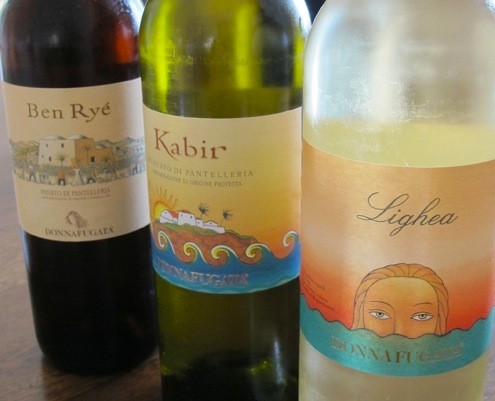Eric Sohl travels to Italy to learn about Donnafugata and Passito wines.
By Eric Sohl
Donnafugata was created in Sicily by an enterprising family with 150 years’ experience in premium wines. Giacomo Rallo and his wife Gabriella, with their children José and Antonio, are engaged in an entrepreneurial project aimed at care for details and at putting people at the service of nature to make wines that increasingly correspond to the territory’s potential.
The Donnafugata adventure began in 1983 in the Rallo family’s historic cellars in Marsala and at its Contessa Entellina vineyards in the heart of western Sicily; in 1989 Donnafugata arrived on the island of Pantelleria, starting to produce naturally sweet wines. Today Donnafugata has about 328 hectares (810 acres) of vineyards in production, of which 260 (642 acres) are in Contessa Entellina and 68 (168 acres) on Pantelleria.
The name Donnafugata, literally “woman in flight” refers to the history of Queen Maria Carolina, wife of Ferdinand IV of Bourbon, who in the early 1800s – fleeing Naples on the arrival of Napoleons troops – sought refuge in the part of Sicily where the winery’s vineyards now stand. This event inspired the winery’s logo, the effigy of a woman’s head with windblown hair found on every bottle.
It was Sicilian author Giuseppe Tomasi di Lampedusa, in his novel Il Gattopardo (The Leopard), who gave the name of Donnafugata to the country estates of the Prince of Salina which hosted the queen and now host the winery’s vineyards.

Vineyards and Cellars
The Contessa Entellina estates are located in the heart of western Sicily, where vineyards are an integral part of the landscape. Immediately after picking, the grapes from 7 different areas are sent to the cellars to be vinified separately. On its 650 acres Donnafugata grows both indigenous grapes – Ansonica, Catarratto, Grecanico and Nero d’Avola – and the international varieties that have proven to adapt best to the pedoclimatic conditions of the different territories of the estate, including Chardonnay, Viognier, Cabernet Sauvignon, Merlot, Syrah as well as Sauvignon Blanc in small quantities. Lately they have also been introduced Alicante Bouchet, Tannat and Petit Verdot. Cultivating 13 varieties was an agronomic decision aimed at valorizing the particularities of the different areas (soil, elevation, exposure) and producing complex wines with great personality.
We visited Donnafugata on Pantelleria and doscovered a whole new world of Passito production. We even got the chance to taste fresh Zibibbo grape juice. The best

On Pantelleria, a volcanic island lying between Sicily and Africa, Donnafugata has 170 acres planted with Zibibbo (Muscat of Alexandria) and a winery in the Khamma district that is a fine example of sustainable architecture. The vines, trained in bush form, are grown on small terraced plots delimited by drywalls in lava stone. These Pantellerian “bushes” are planted in “basins” of hollowed-out earth, are low-lying and molded by the dry, windy climate. Given such conditions, grape growing is almost entirely manual and even harvesting is very laborious. The winery’s vineyards are located in 11 districts of the island differing in soil, altitude, exposure and age (some are more than 100 years old). At the Khamma winery individual batches of grapes are worked separately down to final blending, respecting and enhancing the plurality of viticultural contexts. Here are born Ben Ryé, Kabir and Lighea.
Pantelleria. Heroic viticulture The grape growers’ work on Pantelleria is one of the last examples of heroic viticulture in the Mediterranean. A climate that is arid and windy, vines grown low in bush form, land in small parcels and terraced terrain along with drywall and wind-break maintenance means a great deal of work and raises wine production costs. On Pantelleria 3 times more labor is required than at the winery’s Contessa Entellina vineyards. And in the particular case of Ben Ryé, added to this are the costs of drying the fresh grapes on racks and manually stripping off the dried ones. Only high-quality products, supported by strong territorial identity, can guarantee adequate remuneration for the costs of this kind of production system. Without forgetting that on Pantelleria viticulture is a way of protecting the landscape, an inestimable asset for the island’s economy.

The century-old vineyard, an example of biodiversity.
In 1999, at Khamma, Donnafugata reclaimed a 17.5-acre vineyard of Zibibbo with non-grafted (“piede franco”) vines more than 100 years old. Healthier and with greater longevity than grafted plants, the Zibibbo at Khamma is very resistant to drought, limestone and salinity; its vine/grape growth balance is more harmonious and grape quality is exceptional. The old wood is a great “reservoir” of sugars and during the setting stage they pass into the new wood, reaching the grapes and adding a wealth of aromas to their sugar content. These hundred-year-old vines have made Ben Ryé even more complex and elegant. They grow in sandy terrain of volcanic origin where the virulence of phylloxera (vine pest) is greatly reduced, and they are both an “historic find” and a formidable legacy of biodiversity, as demonstrated by studies conducted by Prof. Mario Fregoni of the Catholic University of Piacenza.














